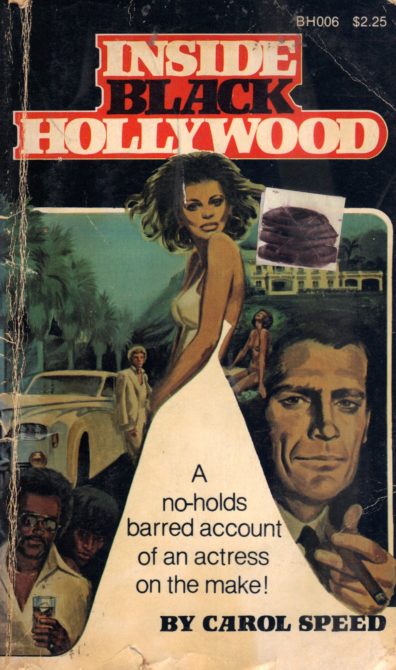 By CAROL SPEED (Holloway House; 1980)
By CAROL SPEED (Holloway House; 1980)
In his (since deleted) online review of the 1973 Blaxploitation classic THE MACK, Quentin Tarantino praises that film’s “Visceral lurid violence” that contains “the snap of a Holloway House trash paperback,” and asks “Where’s the Donald Goines novelization?” Holloway House, for those who don’t know, was a trashy white-owned paperback outfit known for publishing books aimed at black readers (with Donald Goines being one of their most famous and prolific contributors). Tarantino is correct that no novelization exists of THE MACK (by Goines or anyone else), but there does exist a novel about that film, and one published by Holloway House: INSIDE BLACK HOLLYWOOD by actress Carol Speed, who played THE MACK’s female lead.
INSIDE BLACK HOLLYWOOD is the WHITE HUNTER, BLACK HEART of the 1970s Blaxploitation film cycle, a thinly fictionalized (when asked by an interviewer how much of the book is true, Speed answered “It’s all true!”) behind-the-scenes expose. As such this book an above-average example, with many of the more sensational episodes of THE MACK’S production, such as the punching out of its director Michael Camus by co-star Richard Pryor and the murder of its gang-affiliated backer Frank D. Ward, detailed in its pages.
The late Mr. Ward is identified here as Fred Sullivan, an individual with whom the protagonist Dorothy Jean Dickerson is besotted. Dorothy/Carol Speed’s desire for Fred is enumerated in a succession of passages in which she either masturbates thinking about “how Fred’s dick would feel going in and out of my pussy” or gets hot and bothered merely pondering that possibility.
Sex is a major component of Dorothy’s thoughts and actions, and of this book overall, thus fulfilling one of the three major Holloway House mainstays. Of the others, one (drugs) is equally prolific, with Dorothy and her fellow cast members imbibing a wide variety of illegal substances, while the other (violence) is in short supply. This is an account that is admittedly lacking in dramatic incident, but is quite readable nonetheless. Carol Speed hasn’t been a very prolific writer (her only other published writing is a now out-of-print 2002 novel entitled THE GEORGETTE HARVEY STORY), but she demonstrates real storytelling aptitude in a narrative that, in keeping with the realities of moviemaking, is quite uneventful.
The characters caught up in the making of “THE CHANCE” include Henry Worth (a.k.a. THE MACK’s star Max Julien), a constantly scheming actor who Dorothy finds “sickening,” as he’s tasked with “Going around finding the best black talent who were unemployed and allowing the white people to work them for nothing.” There’s also Bubba Johnson (a.k.a. Richard Pryor), a disgraced stand-up comic whose behavior is consistently dangerous and unpredictable; Lisa McLaine (a.k.a. Vonetta McGee), Henry’s obnoxiously aloof superstar girlfriend; the film’s overweight director Mark Katz (a.k.a. Michael Campus), about whom Dorothy laments “Damn it all, why wasn’t he more professional? Sacrificing the film for a piece of tail” (as he does quite often); and Gerald Goldfarb (a.k.a. Harvey Bernhard), the film’s slimy producer, who like Mark happens to be white. All these individuals are uniformly vile and unpleasant, and the relentlessly narcissistic Dorothy (who spends a large portion of the novel checking herself out in mirrors) fits into this sordid scene quite well.
In more recent years Carol Speed appears to have changed her tune regarding THE MACK and its makers (see the 1998 tome WHAT IS IS…WHAT IT WAS!, in which Speed claims the film represented “a special moment and quite a ride”), but the experience related in this book is one of unrelieved ugliness. That may explain why its once scheduled early-00s reprinting never occurred; INSIDE BLACK HOLLYWOOD certainly deserves points for its bluntness and honesty, but the picture it paints of “Black Hollywood” is a dark one indeed.
